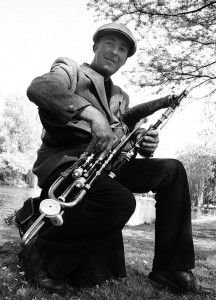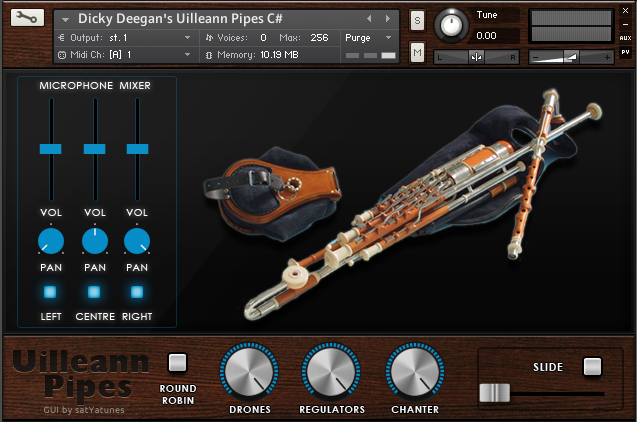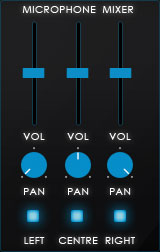The uilleann pipes are the national bagpipe of Ireland. The word uilleann comes from the Irish term píobaí uilleann which means “pipes of the elbow” and refers to the method of inflating the bag. This is done via a set of bellows that are strapped around the player’s waist and are operated by their arm.
Musician
 We had the delight and pleasure of working with renowned uilleann piper Dicky Deegan who came on board to provide the samples for this project. Dicky has been piping for over 30 years and has a wealth of experience both as a solo musician and as part of a group.
We had the delight and pleasure of working with renowned uilleann piper Dicky Deegan who came on board to provide the samples for this project. Dicky has been piping for over 30 years and has a wealth of experience both as a solo musician and as part of a group.
In addition to sessions in London Dicky performs regularly for Stella McCartney and friends and is an original member of Guy Ritchie’s Punchbowl Band in Mayfair.
He has played across the globe and made many appearances at Irish, folk, and world music festivals over the years. He has performed several times at the Sydney Opera House, including one concert held on top of the building’s iconic sails.
Visit Dicky’s website to find out more about him, his upcoming performances, and the uilleann pipes.
Uilleann Pipes Variations
To get the most out of Dicky Deegan’s Uilleann Pipes it is helpful to know a little bit about the components that make up the instrument. There are three main variations.
Practice Set
The practice set is mainly used by beginners but also by advanced players, it consists of just the pipe bag, bellows, and chanter. The chanter is the main melodic pipe of the instrument and is available in a range of keys – the most common being a D chanter. It uses a double-reed to produce its tones.
Half Set
The half set is the same as the practice set with the addition of three drone pipes. The drones can be turned on or off and each produces a single note, the tonic of the chanter.
Unlike the chanter the drones use single-bladed reeds. Each drone produces its note in a different register. The tenor is the highest drone, pitched the same as the lowest note of the chanter. The baritone is pitched one octave lower than the tenor. The bass is the lowest drone and is two octaves below the tenor.
Full Set
A full set is the same as the half set with the addition of three regulators. These are used to provide accompaniment to the chanter. They are played with keys arranged in rows that enable the playing of two or three note chords as well as single notes. Like the drones the regulators are referred to as tenor, baritone, and bass, from smallest to largest. The tunings given here are for a set of pipes in the key of D.
The tenor has five keys tuned C, B, A, G, F#. The baritone has four keys that play A, G, F#, D. The bass also has four keys which sound C, B, A, G, one octave below the tenor. Dicky Deegan’s Uilleann Pipes features a rare fourth regulator known as the double-bass which has two notes C#, and D, an octave below the bass. The number of notes available on a double-bass regulator varies between sets.
You’ll notice that both the tenor and baritone can play the same A, G, and F#, which allows for more options when playing chords, as each pipe can only sound one note at a time. We’ve incorporated this into our sample library, using velocity to determine if the sample for these notes comes from the tenor or the baritone regulator.
The instruments Dicky plays and that we recorded are a Geoff Woof Full Set in C# and D set by Matt Kiernan.
Patches
The professional edition of this sample library comes with four Kontakt instruments. There are two for the D set of pipes and two for the C# set. For both sets we created a standard patch featuring smooth, steady samples, ready to be crafted into a performance; and a second patch that is a little less tame with more of the musician’s raw emotion in each sample. The standard and untamed patches share the same drones samples.
Main Interface
The interface was designed by satYatunes. It features a microphone mixer, individual volume controls for the drones, regulators, and chanter, a round robin on/off switch, and a fader to control the length of the playable slides.
Microphone Mixer
We recorded Dicky Deegan’s Uilleann Pipes sample library with three microphones, a stereo cardioid pair at the left and right of the instrument and a single omni-direction microphone in the centre. The way the instrument is held lends itself well to this microphone arrangement as the pipes are laid across the musicians leg with the bellows on one side, the bag on the other, and the chanter roughly in the centre.
The mixer enables you to control the volume and panning of each microphone. The blue button beneath each channel strip can be used to unload that microphone’s samples.
Pipe Volume Knobs
In a live performance the musician doesn’t have much control over the volumes of the individual pipes. However it can often be desirable to adjust the balance between the different types of pipe and because we recorded them separately we can control this with greater precision.
These three knobs at the bottom of the interface can be used to adjust the level of the drones, regulators, and chanter independently – taking into account the volume settings of the individual microphones. Keep in mind that the settings you define here aren’t necessarily achievable on the real instrument.
Slide
Sliding into notes is a classic uilleann pipes chanter technique. Enabling the slide button allows you to perform formant correct slides of up to one whole tone, either up or down in pitch. This button can be enabled by clicking it, via a keyswitch (see below), or by your sustain pedal (CC#64).
The duration of the slide is set by the fader underneath the button. With this fader at its lowest setting (as shown in the image) the slide time will be determined by the velocity that the second note of the slide is played at; a lower velocity provides a longer slide.
In this mode you’ll see the fader briefly jump up to the calculated time when you perform a slide. Setting the fader to any other position disables the velocity control and the length of the slide will be determined purely by the position of the fader. The closer the fader is to the right the longer the slide will be.
Round Robin
Dicky Deegan’s Uilleann Pipes includes a round robin repetition feature that can be toggled on or off with this button. The button can also be controlled using a keyswitch (see below). For the regulators and chanter the repetitions are created using adjacent samples, while the drones use three separate sample sets.
Keyboard Layout
The yellow keys (C0 – D0) are used to activate the drone samples. These are toggle keys and can be used to turn the drones on or off, just like on the real instrument. Unlike normal keyswitches these are velocity sensitive, triggering them at a velocity below 65 will enable them, while a velocity above 65 will be disable them. This is very helpful when playing back your sequences in a DAW as it prevents the switch from toggling on and off each time playback is restarted.
The green keys trigger the regulator samples, these are polyphonic. The samples are mapped one octave below their sounding pitch to prevent them overlapping with the chanter samples. For those notes that can be played on both the baritone and tenor pipes playing a velocity below 65 will trigger the baritone samples and a velocity of 65 or greater will trigger the tenor samples. For the D instruments those notes are F#2, G2, and A2, and for the C# instruments the notes are F2, F#2, and G#2.
The blue keys trigger the chanter samples. These are monophonic and playing in an overlapped style will trigger legato transitions between the notes. You can also perform trills, using the built in retrigger by holding down one note and repeatedly pressing a second.
The red keys are used to toggle the round robin button (C6) and the slide button (D6). Like the yellow drone keys these are velocity sensitive.
Controllers
Dicky Deegan’s Uilleann Pipes respond to a selection of common controller numbers that you can use to create unique performances.
Velocity
The attack of the regulators and chanter is linked to velocity, playing a higher velocity will result in a shorter attack. The chanter also makes use of other velocity controlled and scripted elements that allow you to perform on knee and off knee notes depending on the played velocity.
Modulation
The modulation wheel (CC#1) can be used to control the amount of chanter vibrato. Increasing the controller value increases the speed and intensity of the vibrato. The untamed patches feature more natural vibrato and pitch wobble than the standard patches.
Pitch Bend
The pitch bender in this library has been configured to slide by either a half tone or a whole tone depending on which direction the pitch wheel is moving. Bending toward the controller’s lowest position will produce a whole tone slide, while bending to the highest position will create a semitone slide.
Moving the controller from its centre position will produce a downwards slide (this is not very common in uilleann pipes music) while moving towards the centre will create an upwards slide. Only the chanter will respond to the pitch bend wheel. Unlike the instrument’s scripted slide feature using the pitch bender does not produce a formant correct slide.
Sustain Pedal
The sustain pedal (CC#64) can be used as a momentary switch to toggle the slide button on the interface.
Custom
As well as being able to adjust the knobs, sliders, and buttons on the interface with your mouse you can also control them with Kontakt’s CC automation. Just right click on a control and select “Learn MIDI CC# Automation”, then move one of your MIDI continuous controllers to assign its CC number to that control. You can assign the same CC number to several controls in this way. Do remember that CC#1 and CC#64 are already assigned to the instrument internally and you may want to avoid assigning these to controls on the interface.
Bellows and Bag Noises
Both the professional and lite editions of Dicky Deegan’s Uilleann Pipes sample library include an extra bellows and bag noise instrument. These are recordings of the Dicky filling the pipe bag with air before and during the performance. The level of these samples can be controlled by velocity.
Acknowledgments
Musician: Dicky Deegan (sample recordings only)
Recording Technician: Sarah McNeill
Sample Editing & Scripting: David Healey
GUI Design: satYatunes
Uilleann Pipes Image: Andreas Rogge





